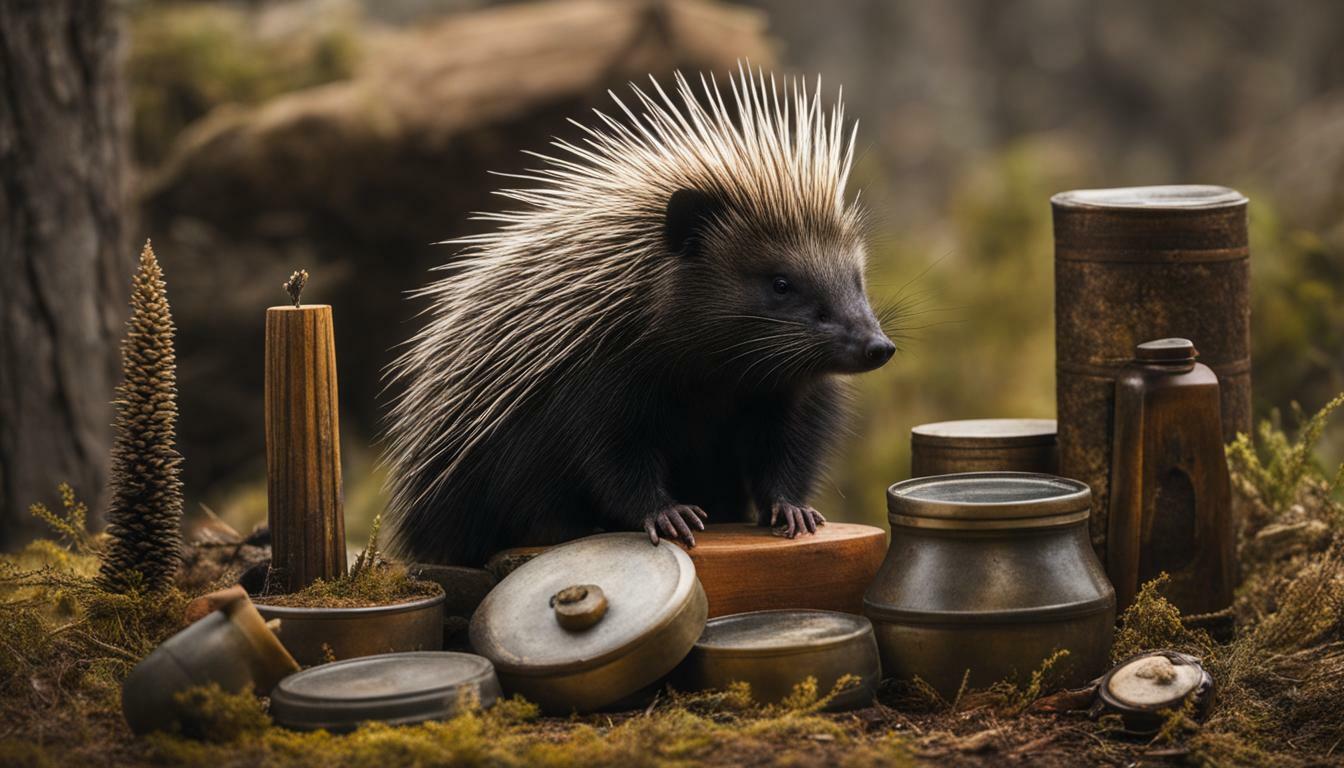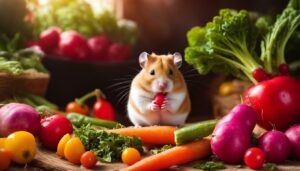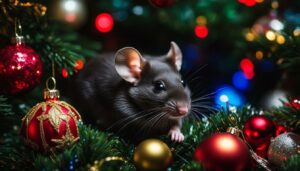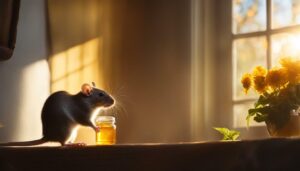Porcupine size varies, but on average, they can grow to be between 2 to 3 feet long. These fascinating creatures are the second largest rodent in North America, following beavers. With their stocky bodies, short legs, and a short, thick tail, porcupines have a distinctive appearance that sets them apart. Their dark brown or black fur is adorned with white highlights, creating a striking contrast.
One of the most recognizable features of porcupines is their coat of quills. These quills cover their entire body, except for their underbelly, face, and feet. Adult porcupines have approximately 30,000 quills, which are sharp, barbed, hollow spines. Ranging from 1 to 3 inches in length, these quills have small barbs on the end, making them easily attach to an attacker’s flesh for defense.
Despite their impressive armor, porcupines have poor eyesight. However, they compensate for this with their excellent sense of smell and hearing. These sensory capabilities help them navigate their surroundings and locate food sources.
Porcupines are herbivores, and their diet consists of various vegetation, including twigs, roots, stems, berries, leaves, and bark. They can be found in different habitats, such as coniferous and mixed forests, shrublands, and even tundra. Porcupines are primarily solitary animals but may share dens with other porcupines during the winter months. While they are not hibernators, they may seek shelter in their dens during unfavorable weather conditions.
When it comes to reproduction, porcupines breed once a year. After a gestation period of 210 days, a female porcupine gives birth to a single offspring. The young porcupine is nursed for about 127 days and becomes independent at around 5 months of age.
With a lifespan of up to 18 years, porcupines are not considered threatened and do not face any major threats to their population. Their natural defenses and adaptability have contributed to their survival in various environments.
Key Takeaways:
- Porcupines can grow between 2 to 3 feet long on average.
- They have a stocky body, short legs, and a short, thick tail.
- Porcupines possess around 30,000 sharp, barbed quills.
- They have poor eyesight but compensate with an excellent sense of smell and hearing.
- Porcupines are herbivores and consume a variety of vegetation.
Porcupine Length and Weight
Adult porcupines can weigh between 11 to 20 pounds and measure between 2 to 3 feet in length. They are the second largest rodent in North America, following beavers. Porcupines have a stocky body, short legs, and a short, thick tail. Their coloration typically consists of dark brown or black fur with white highlights, providing them with effective camouflage in their surroundings.
One of the most defining features of porcupines is their coat of quills, which cover their entire body except for their underbelly, face, and feet. These quills serve as a means of self-defense, as they are sharp, barbed, hollow spines that can easily penetrate the flesh of an attacker. With an average of about 30,000 quills, an adult porcupine possesses a formidable defense mechanism.
The porcupine’s quills range in length from 1 to 3 inches and are equipped with small barbs at the end, making them difficult to remove once they have penetrated an assailant’s skin. It is important to note that while porcupines do not shoot their quills, they can release them easily upon contact. This serves as a deterrent for potential predators, as the quills can become embedded in the attacker’s skin, causing pain and discomfort.
Porcupine Size Overview:
| Weight Range | Length Range |
|---|---|
| 11-20 pounds | 2-3 feet |
Despite their large size and impressive defense mechanisms, porcupines possess poor eyesight. However, they compensate for this with their excellent sense of smell and hearing. These sensory capabilities allow them to navigate their environment effectively and detect potential threats or sources of food.
Porcupines are herbivorous creatures with a varied diet that includes twigs, roots, stems, berries, leaves, and bark. They are adaptable and can be found in various habitats, including coniferous and mixed forests, shrublands, and even tundra regions. While they are generally solitary animals, porcupines may den with other porcupines during the winter months for added warmth and protection.
Porcupines have a lifespan of up to 18 years and breed once a year. After a gestation period of approximately 210 days, a female porcupine gives birth to a single offspring. The young porcupine is nursed for about 127 days and becomes independent at around 5 months of age.
Fortunately, porcupines are not considered threatened, and their populations face no significant threats. Their impressive size and unique adaptations allow them to thrive in their natural habitats without major risks to their survival.
Porcupine Anatomy
Porcupines have a stocky body, short legs, and a unique coat of quills. They are the second largest rodent in North America, surpassed in size only by beavers. These fascinating creatures typically measure between 2 to 3 feet in length and weigh around 11 to 20 pounds. Their bodies are usually dark brown or black in color, with striking white highlights that add to their distinctive appearance.
One of the most remarkable features of porcupines is their coat of quills. These sharp, barbed, hollow spines cover the entire body of the porcupine, except for their underbelly, face, and feet. An adult porcupine can have approximately 30,000 quills, each measuring around 1 to 3 inches in length. The quills play a vital role in defense, as they can easily penetrate the flesh of an attacker. The small barbs on the end of each quill make them particularly effective at deterring predators.
In terms of sensory capabilities, porcupines have poor eyesight but compensate with an excellent sense of smell and hearing. These traits help them navigate their surroundings and detect potential dangers. Their acute sense of smell aids in locating food sources, while their hearing allows them to be aware of any imminent threats. Together, these sensory abilities contribute to the porcupine’s survival in its various habitats.
| Anatomy | Characteristic |
|---|---|
| Body | Stocky |
| Legs | Short |
| Quills | Sharp, barbed, hollow spines |
| Senses | Poor eyesight, excellent sense of smell and hearing |
Porcupines prefer a herbivorous diet, feeding on various vegetation such as twigs, roots, stems, berries, leaves, and bark. They can be found in diverse habitats, including coniferous and mixed forests, shrublands, and even tundra. While porcupines are predominantly solitary creatures, they may den with other porcupines during the winter months. Although they are not true hibernators, porcupines may seek shelter in their dens during inclement weather.
When it comes to reproduction, porcupines follow an annual breeding cycle. After a gestation period of approximately 210 days, a female porcupine gives birth to a single offspring. Young porcupines are nursed for around 127 days before becoming independent at approximately 5 months of age. With a lifespan of up to 18 years, porcupines enjoy a relatively long life compared to other small mammals. Fortunately, they are not considered threatened and face no significant population threats at present.
Porcupine Quills
Adult porcupines have approximately 30,000 sharp, barbed quills that are about 1 to 3 inches long. These quills are a defining characteristic of porcupines and serve as their primary form of defense. When the porcupine feels threatened, it raises its quills, making itself appear larger and more intimidating to potential predators. The quills are made of keratin, the same material found in our hair and nails, and are hollow, which allows them to easily penetrate the flesh of an attacker.
The porcupine’s quills are not like traditional needles; they have small barbs on the end, which make them even more effective in self-defense. When an animal comes into contact with the quills, the barbs latch onto the flesh, making it difficult and painful to remove them. Contrary to popular belief, porcupines cannot ‘shoot’ their quills, but they can release them easily upon contact. This is why it is often wise to give these intriguing creatures a wide berth to avoid any accidental encounters with their formidable quills.
Porcupines have evolved a remarkable defense mechanism with their quills, making them one of nature’s most unique and fascinating creatures.
Porcupine Anatomy
Aside from their quills, porcupines have other distinguishing physical features. They have a stocky body, short legs, and a short, thick tail. Their dense fur ranges in color from dark brown to black, with white highlights on their face, underbelly, and feet. These color patterns provide camouflage and help them blend into their natural surroundings. The porcupine’s anatomy is well-suited for their arboreal lifestyle, which involves climbing trees and navigating forested environments with ease.
Porcupines are fascinating creatures with unique adaptations, from their sharp quills to their distinct physical characteristics. Understanding their anatomy and behavior sheds light on their remarkable survival strategies and their place in the natural world.
| Characteristic | Description |
|---|---|
| Quill Length | Approximately 1 to 3 inches |
| Number of Quills | Approximately 30,000 |
| Quill Material | Keratin, hollow structure |
| Barbs | Present on the end of the quills |
| Colors | Dark brown or black with white highlights |
| Body Features | Stocky body, short legs, short tail |
Porcupine Senses
Porcupines have a limited eyesight but compensate with a keen sense of smell and hearing. Their sense of smell is particularly important, helping them locate food sources and detect predators. With their long nose and strong olfactory receptors, porcupines can pick up scents from a distance, allowing them to navigate their environment and find suitable vegetation to eat.
In addition to their sense of smell, porcupines have excellent hearing. Their large, prominent ears are designed to capture and process sounds efficiently. This keen sense of hearing allows them to detect the subtlest of noises, alerting them to potential dangers or approaching predators. Porcupines can also communicate with other members of their species using vocalizations.
While their eyesight is limited, porcupines are not completely blind. They have small, round eyes that are adapted for low-light conditions. Although they cannot see in color, they can perceive light and darkness, which is sufficient for their nocturnal lifestyle. This diminished eyesight is offset by their other heightened senses, allowing them to survive and thrive in their natural habitats.
| Senses | Characteristics |
|---|---|
| Smell | Keen sense of smell, helpful for finding food and detecting predators. |
| Hearing | Excellent hearing, able to detect subtle noises and communicate with others. |
| Eyesight | Limited eyesight, adapted for low-light conditions but not color perception. |
Overall, porcupines rely on their acute sense of smell and hearing to navigate their environment and ensure their survival. These sensory abilities aid them in finding food, avoiding predators, and communicating with other porcupines in their solitary lives. While their physical appearance may be intimidating with their coat of quills, porcupines have evolved an impressive set of senses that allow them to thrive in their natural habitats.
Porcupine Diet and Habitat
Porcupines are herbivores that feed on a variety of vegetation and can be found in various habitats such as forests, shrublands, and tundra. They have a diverse diet, consuming twigs, roots, stems, berries, leaves, and bark. Porcupines are equipped with strong incisors that allow them to gnaw through tough vegetation, enabling their herbivorous lifestyle. Their preference for different types of vegetation can vary based on availability and location.
In forested areas, porcupines often feed on the inner bark of trees, which can have significant ecological effects. Bark consumption can impact tree health and survival, and in some cases, even lead to tree death. In shrublands and tundra, porcupines browse on a variety of shrubs, plants, and grasses.
Porcupines’ habitat preference is influenced by the availability of food sources and suitable shelter. They are commonly found in coniferous and mixed forests, where they can take advantage of the abundant trees and vegetation. The dense cover provided by these forests offers protection and shelter. Shrublands and tundra, with their open and less dense vegetation, also provide suitable habitat for porcupines.
Overall, porcupines play an important role in the ecosystems they inhabit. By consuming vegetation, they can shape the structure and composition of plant communities. Additionally, their feeding habits can influence the regeneration and succession of forests. Despite their spiky appearance and formidable quills, porcupines are primarily peaceful creatures, coexisting with other wildlife in their habitats.
| Porcupine Diet | Porcupine Habitat |
|---|---|
|
|
Porcupine Behavior
Porcupines are solitary animals that may den with others during winter months but are not hibernators. They prefer to live alone and establish territories to avoid competition for resources. However, during harsh winters, several porcupines may share a den to conserve heat and increase their chances of survival.
Despite their solitary nature, porcupines are not aggressive animals and generally, only use their quills for self-defense. When threatened, they will raise their quills and make warning sounds to deter predators. If these warning signs are ignored, porcupines can deliver painful quill injuries by swinging their tails or rolling into their attackers.
“When threatened, porcupines will raise their quills and make warning sounds to deter predators.”
Porcupine Denning
Porcupines are known for their elaborate denning habits. They create dens in hollow trees, rock crevices, or burrows dug into the ground. These dens provide shelter and protection against extreme weather conditions and predators. Porcupines often line their dens with grass, leaves, and other soft materials for added comfort.
During the winter months, porcupines may stay in their dens for extended periods, conserving energy and relying on their fat reserves. They do not truly hibernate but rather enter a state of torpor, where their metabolic rate and body temperature decrease to save energy. However, they remain active and may venture outside their dens on milder days to forage for food.
Porcupine Communication
While porcupines are generally quiet creatures, they do communicate through a variety of vocalizations. These include growls, grunts, and high-pitched cries, which are used to express different emotions such as fear, aggression, or mating intentions.
Aside from vocalizations, porcupines also communicate through scent marking. They have scent glands located on their feet and other parts of their body, which they use to mark their territories and communicate with other porcupines. These scent marks contain pheromones that convey information about the porcupine’s age, sex, and reproductive status.
| Porcupine Behavior | Description |
|---|---|
| Solitary Nature | Porcupines prefer to live alone and establish territories to avoid competition for resources. |
| Denning Habits | Porcupines create dens in hollow trees, rock crevices, or burrows dug into the ground for shelter and protection against harsh weather conditions and predators. |
| Self-Defense | Porcupines use their quills for self-defense. When threatened, they raise their quills and make warning sounds to deter predators. |
| Communication | Porcupines communicate through vocalizations such as growls, grunts, and cries. They also use scent marking to convey information about their territories and reproductive status. |
Porcupine Reproduction
Porcupines breed once a year, with a gestation period of approximately 210 days, after which a female gives birth to a single offspring. The reproductive behavior of porcupines is fascinating and unique. During the breeding season, males compete for the attention of females by engaging in vocalizations and physical displays. Once a female has chosen a mate, they engage in a mating ritual that can last several minutes. After mating, the female will carry her offspring for the duration of the gestation period.
When the time comes to give birth, the female porcupine will find a sheltered area, such as a den or hollow tree, to provide a safe environment for her newborn. The baby porcupine, known as a porcupette, is born with soft quills that harden within a few hours. These quills serve as a form of protection from predators and are essential for the survival of the porcupette.
After birth, the mother porcupine will nurse her porcupette for about 127 days, providing essential nutrients and care to ensure its growth and development. During this time, the porcupette will rely solely on its mother’s milk for sustenance. As the porcupette grows older, it will gradually begin to eat solid foods and become more independent. By around 5 months of age, the young porcupine will have reached a stage where it can survive on its own.
| Reproductive Behavior | Gestation Period | Offspring |
|---|---|---|
| Porcupines engage in a complex mating ritual | Approximately 210 days | A single porcupette is born |
It is important to note that the reproductive cycle of porcupines can vary slightly depending on factors such as climate and food availability. However, the general pattern of breeding once a year and giving birth to a single offspring remains consistent among porcupine populations.
Porcupine Lifespan and Threats
Porcupines have a lifespan of up to 18 years and are not considered threatened, facing no major population threats. These fascinating creatures have adapted well to their environment and have few natural predators. Their formidable quills serve as a powerful defense mechanism, deterring most would-be attackers.
Despite their relative safety in the wild, porcupines do face some risks in certain situations. One of the main threats to their population is habitat loss. As human development expands into natural areas, porcupines may lose their habitats, forcing them to adapt or migrate to new locations.
Another potential danger to porcupines is predatory animals that have developed techniques for dealing with their quills. Animals like fishers and bobcats have learned to attack porcupines from the face or belly, where the quills are less likely to penetrate. While these instances are relatively rare, they can still pose a threat to individual porcupines.
| Threats to Porcupines | Impact |
|---|---|
| Habitat Loss | Displacement and potential population decline |
| Predatory Animals | Potential injury or death for individual porcupines |
Despite these threats, porcupines generally thrive in their natural habitats and have stable populations. Their ability to adapt to different environments and their unique defensive mechanisms have contributed to their long-term survival. With their impressive lifespan and minimal population threats, porcupines continue to be a fascinating and successful species in the animal kingdom.
Conclusion
In conclusion, porcupines can grow to be between 2 to 3 feet long, with an average weight range of 11 to 20 pounds. They are the second largest rodent in North America, after beavers. With their stocky body, short legs, and short, thick tail, porcupines have a distinctive appearance. They are usually dark brown or black in color, with white highlights.
One of the most notable features of porcupines is their coat of quills that covers their entire body except for their underbelly, face, and feet. An adult porcupine has about 30,000 quills, which are sharp, barbed, hollow spines. These quills are used for defense and can easily penetrate the flesh of an attacker. Ranging from 1 to 3 inches in length and with small barbs on the end, these quills provide effective protection for the porcupine.
Although porcupines have poor eyesight, they compensate with an excellent sense of smell and hearing. As herbivores, porcupines have a varied diet consisting of twigs, roots, stems, berries, leaves, and bark. They are adaptable creatures found in various habitats, including coniferous and mixed forests, shrublands, and tundra.
Porcupines are solitary animals, but during the winter, they may den with other porcupines. While they are not hibernators, they may choose to stay in their dens during bad weather. With a lifespan of up to 18 years, porcupines breed once a year, and after a gestation period of 210 days, a female gives birth to a single offspring. Young porcupines are nursed for about 127 days and become independent at around 5 months of age.
Fortunately, porcupines are not considered threatened and have no major threats to their population. These fascinating creatures continue to thrive in their natural habitats, contributing to the diversity of North American wildlife.
FAQ
How big do porcupines get?
Porcupines can grow to be between 2 to 3 feet long and weigh between 11 to 20 pounds.
What is the average size of a porcupine?
The average size of a porcupine is between 2 to 3 feet long and weighs between 11 to 20 pounds.
What is the second largest rodent in North America?
The second largest rodent in North America is the porcupine, after beavers.
How are porcupines physically structured?
Porcupines have a stocky body, short legs, and a short, thick tail.
What color are porcupines?
Porcupines are usually dark brown or black in color, with white highlights.
How many quills does an adult porcupine have?
An adult porcupine has about 30,000 quills.
What are porcupine quills used for?
Porcupine quills are used for defense and can easily penetrate the flesh of an attacker.
How long are porcupine quills?
Porcupine quills are about 1 to 3 inches long.
Where are porcupine quills found on their body?
Porcupine quills cover their entire body except for their underbelly, face, and feet.
How many barbs do porcupine quills have?
Porcupine quills have small barbs on the end.
What are the sensory capabilities of porcupines?
Porcupines have poor eyesight but have an excellent sense of smell and hearing.
What do porcupines eat?
Porcupines are herbivores and eat a variety of vegetation, including twigs, roots, stems, berries, leaves, and bark.
Where are porcupines found?
Porcupines are found in various habitats, including coniferous and mixed forests, shrublands, and tundra.
Do porcupines hibernate?
Porcupines are not hibernators but may stay in their dens during bad weather.
What is the lifespan of a porcupine?
Porcupines have a lifespan of up to 18 years.
How often do porcupines breed?
Porcupines breed once a year.
How long is the gestation period for porcupines?
The gestation period for porcupines is 210 days.
How many offspring do porcupines give birth to?
A female porcupine gives birth to a single offspring.
How long are porcupine young nursed for?
Porcupine young are nursed for about 127 days.
At what age do porcupines become independent?
Porcupines become independent at around 5 months of age.
Are porcupines considered threatened?
Porcupines are not considered threatened and have no major threats to their population.




